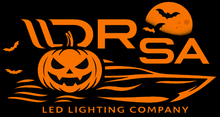Definition of Color Temperature
Color temperature describes how warm or cool a light source appears to the eye. It’s measured in Kelvin (K), the unit used to define the tone of visible light. Marine LED fixtures typically range between 2,000K and 6,500K, offering different lighting effects depending on the desired mood and purpose on board.
-
2,000–3,500K (Warm White): Creates a cozy, golden glow ideal for cabins, lounges, and dock areas.
-
5,000–6,500K (Cool White): Delivers bright, blue-white illumination that enhances visibility in workspaces or engine rooms.
On your vessel, color temperature determines not only how lighting looks but also how it feels. Warm light invites relaxation, while cool light sharpens focus and detail for safety and navigation.
Understanding the Kelvin Light Scale
To understand color temperature, it helps to visualize where your lights fall on the Kelvin spectrum. The Kelvin scale measures the “color” of light based on how a heated blackbody radiator emits light at various temperatures.
While it might sound counterintuitive, higher Kelvin values represent cooler tones. A blue flame is hotter and therefore bluer than a yellow one. This is why a 6,000K LED looks crisp and cool, while a 2,700K LED gives off a soft, amber hue.
This concept originated from physicist Max Planck’s research, which formed the foundation for how we measure and standardize color temperature today.
Color Temperature Chart (Kelvin Light Scale)
| Color Temperature (Kelvin) | Light Appearance | Ideal Marine Applications |
|---|---|---|
| 2000–2700K | Extra warm white, amber glow | Dock lighting, piling lights, underwater ambient lighting |
| 2700–4000K | Warm white with yellow tone | Cabins, salons, interior downlights, ambient cockpit lighting |
| 4000–5000K | Neutral white, balanced color | Deck lights, bait stations, work surfaces, chart tables |
| 5000–6500K | Cool daylight, crisp white | Engine rooms, hardtops, radar arches, navigation lighting |
| 6500K+ | Bright blue-white daylight | Searchlights, inspection areas, professional camera use |
When viewed on the Kelvin light scale, lower numbers (2,000–3,000K) lean toward red and orange tones, while higher numbers (5,000–6,500K) lean toward white and blue hues.
Why It Matters for Boat Lighting
Color temperature directly affects visibility, safety, and ambiance aboard your vessel. The right color tone can help you move comfortably between relaxing and working environments:
-
Warm white (2,700–3,500K): Perfect for creating inviting dockside spaces and cozy cabins.
-
Neutral white (4,000–5,000K): Ideal for accurate color perception and detail work on deck.
-
Cool white (5,000–6,500K): Best for high-visibility areas like engine compartments and navigation zones.
For example, DRSA’s Black LED Piling Light Caps RGBW Dock Lighting 12V allow you to customize the color temperature and tone around your dock or pier. You can switch between warm amber for ambiance or bright white for safety and clarity, all while enhancing your dock’s nighttime aesthetic.
Example in a Sentence
“The captain installed 3,000K warm white LEDs on the aft deck and 6,000K cool whites in the engine room, creating the perfect balance between comfort and function.”
Related Lighting Terms
-
Correlated Color Temperature (CCT): A standard measure comparing a light’s hue to that of an ideal blackbody radiator.
-
Kelvin Scale: The scientific temperature scale used to define the tone of visible light.
-
White Balance: Adjusting lighting or camera settings so that white objects appear neutral under different light sources.
Explore Marine Lighting at DRSA.com
From underwater RGBW piling lights to engine room fixtures and navigation lights, DRSA carries a full range of LED solutions for every Kelvin preference.
Shop now and find your perfect color temperature:
👉 DRSA LED Piling Light Caps – RGBW Dock Lighting 12V
